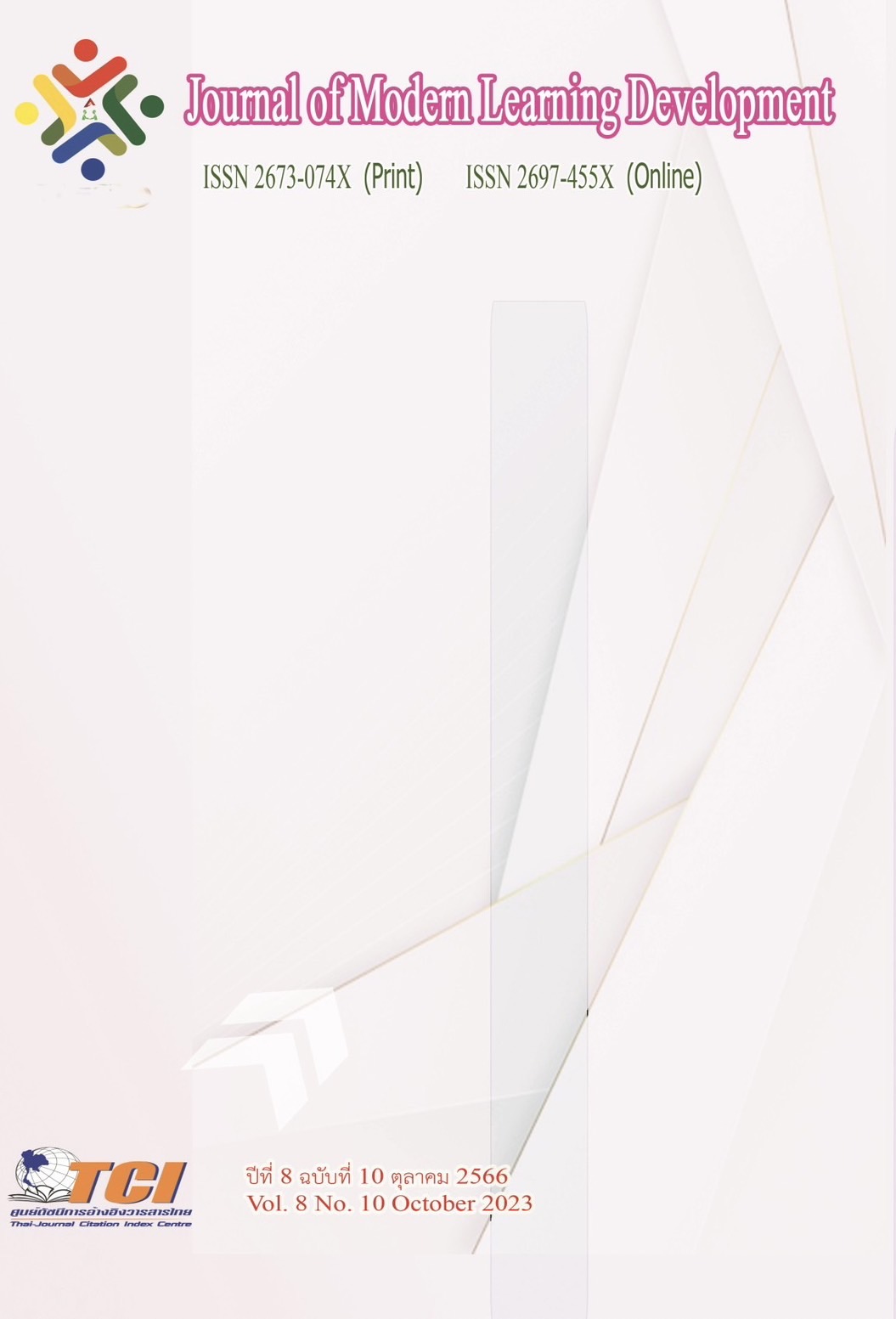The Development of Imaginative and Creative Store Writing by Using Experiential Learning with Creative Storyline Writing Technique for Grad 6 Students
Main Article Content
Abstract
The purposes of this study were 1) to develop the experiential learning with storyline writing technique lesson plans for grade 6 students 2) to compare the imaginative and creative writing achievement by using experiential learning with storyline writing technique for grade 6 students between pre-learning and post-learning 3) to compare the imaginative and creative writing achievement by using experiential learning with storyline writing technique for grade 6 students between the post-learning and the 70 percent criterion, and 4) to study the satisfaction of learning by experiential learning with storyline writing technique for grade 6 students. The sample, selected through the purposive sampling consisted of 21 grade 6 students in the second semester of the 2022 academic year studying at Watphrafang School. The instruments for this study were four the experiential learning with storyline writing technique lesson plans, the imaginative and creative writing achievement pre and posttest, and a satisfaction survey of grade 6 students towards learning by experiential learning with storyline writing technique. The data were analyzed by Mean, Percentage, Standard Deviation (S.D.), t-test dependent, and t-test One-Sample.
The results of this study showed that 1) The experiential learning with storyline writing technique lesson plans were suitable in various element at the high level ( = 4.38, S.D. = 0.85) 2) The imaginative and creative writing achievement by using experiential learning with storyline writing technique was higher than before learning at the significance level of .05.
3) The imaginative and creative writing achievement by using experiential learning with storyline writing technique was higher than the 70 percent criterion at the significance level at .05 and 4) The satisfaction of students towards learning by by using experiential learning with storyline writing technique was the highest level ( = 4.63, S.D = 0.82)
Article Details
References
กระทรวงศึกษาธิการ. (2551). หลักสูตรแกนกลางการศึกษาขั้นพื้นฐาน พุทธศักราช 2551. กรุงเทพมหานคร: ชุมนุมสหกรณ์การเกษตรแห่งประเทศไทย จำกัด.
กิตติคม คาวีรัตน์. (2553). การพัฒนารูปแบบการจัดการเรียนรู้เชิงประสบการณ์เพื่อสร้างเสริมสุขภาวะ สำหรับนักศึกษามหาวิทยาลัยราชภัฏ. วิทยานิพนธ์ปริญญามหาบัณฑิต. สาขาวิชาหลักสูตรและการสอน คณะศึกษาศาสตร์. บัณฑิตวิทยาลัย: มหาวิทยาลัยศิลปากร.
พระมหาณัฐพงศ์ คำมี. (2564). การพัฒนาผลสัมฤทธิ์การอ่านจับใจความโดยใช้นิทานธรรมบท เสริมด้วยเทคนิคการสอนแบบ Storyline สำหรับนักเรียนชั้นมัธยมศึกษาปีที่ 3. การค้นคว้าอิสระปริญญามหาบัณฑิต คณะศึกษาศาสตร์. บัณฑิตวิทยาลัย: มหาวิทยาลัยนเรศวร.
โรงเรียนวัดพระฝาง. รายงานประจำปีของสถานศึกษา (Self-Assessment Report : SAR) ประจำปีการศึกษา 2563. อุตรดิตถ์: โรงเรียนวัดพระฝาง.
สมศักดิ์ ภู่วิภาดาวรรธน์. (2553). หลักการสอนเพื่อพัฒนาผู้เรียนและการประเมินตามสะภาพจริง. กรุงเทพมหานคร: ดวงกมลพับลิชชิ่ง.
สุจิตรา ตรีรัตนนุกูล. (2562). การพัฒนากิจกรรมการเรียนรู้เชิงประสบการ สำหรับส่งเสริมกรอบ ความคิดด้านเชาว์ปัญญาของนักศึกษาระดับอาชีวศึกษา. วิทยานิพนธ์ปริญญามหาบัณฑิต สาขาวิชาการวิจัยและสถิติทางวิทยาการปัญญา. บัณฑิตวิทยาลัย: มหาวิทยาลัยบูรพา
อารีย์ ศรีสุกอง. (2562). ผลการจัดการเรียนรู้แบบประสบการณ์ ที่มีต่อผลสัมฤทธิ์ทางการเรียน เรื่อง ความน่าจะเป็น สำหรับนักเรียนชั้นมัธยมศึกษาปีที่ 3. การค้นคว้าอิสระปริญญามหาบัณฑิต สาขาวิชาหลักสูตรและการสอน. บัณฑิตวิทยาลัย: มหาวิทยาลัยนเรศวร.


